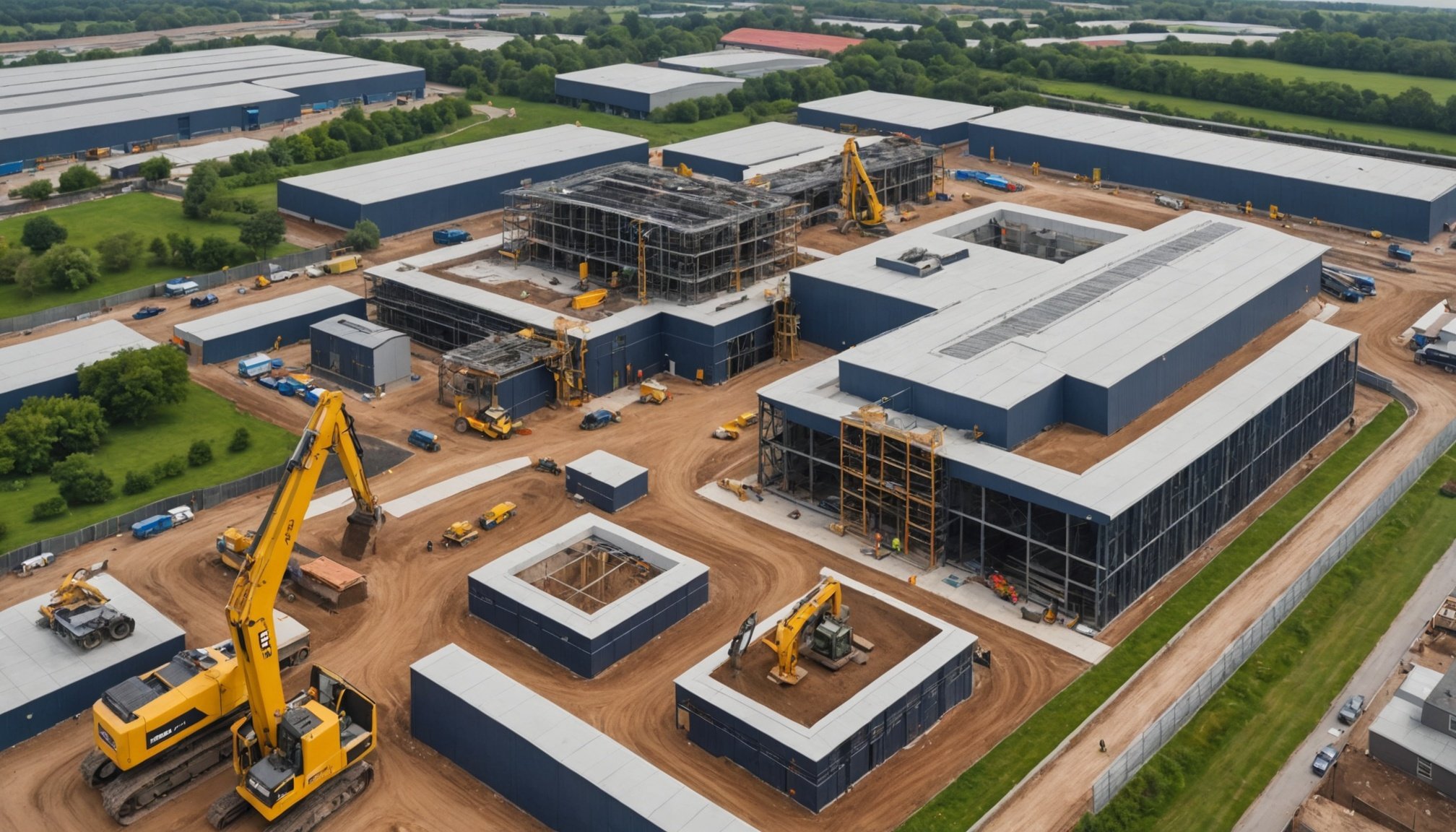Understanding Eco-Friendly Construction in the UK
Eco-friendly construction focuses on reducing the environmental impact of building processes. This movement aims to optimize resource efficiency and minimize waste. The UK’s construction industry has embraced this shift, with sustainable building practices becoming increasingly mainstream.
Definition and Principles
At its core, eco-friendly construction involves adopting practices that are environmentally responsible and resource-efficient. It includes using sustainable materials, conserving water and energy, and ensuring buildings blend seamlessly into local ecosystems. By embracing green techniques, builders contribute to a more sustainable future.
Also to discover : Comprehensive Blueprint for Starting a Medicinal Cannabis Enterprise in the UK;203The Ultimate Blueprint for Creating a Holistic Wellness Retreat in the UK
Sustainability Trends in the UK
The UK construction industry is witnessing a significant shift toward sustainability. Builders increasingly opt for materials that are both eco-friendly and cost-effective, fueled by technological advancements and consumer demand. Energy-efficient systems and renewable energy sources are common features, reflecting these industry trends.
Benefits for Businesses and the Environment
Adopting sustainable building practices offers numerous advantages. Businesses can enhance their reputations while potentially reducing long-term costs through energy savings. For the environment, the benefits include reduced carbon emissions, less waste, and the conservation of natural resources. Companies that embrace these trends are not only meeting regulatory requirements but also positioning themselves at the forefront of innovation.
Have you seen this : Kickstart Your UK E-Bike Rental Venture: Essential Road Safety Compliance Guide
Research and Market Analysis
In-depth market analysis is crucial before venturing into eco-friendly construction. Delving into the current landscape enables businesses to identify gaps and opportunities within the sector. Critical first steps include pinpointing the target audience and recognising their eco-friendly construction needs. Understanding customer desires helps companies tailor services, ensuring alignment with demands for sustainability.
Evaluating competitors plays a pivotal role as well. A comprehensive competitor analysis sheds light on best practices and areas where other companies excel, providing insights that can differentiate one’s venture. By analysing the competitive eco-friendly landscape, businesses can uncover opportunities to innovate or enhance existing offerings, thereby gaining a competitive edge.
Additionally, understanding competitors’ strategies helps in predicting industry trends and shifts. Reviewing other participants’ journeys can guide new entrants on improving methodologies and highlighting unique value propositions. Fostering a stronghold in this growing industry becomes more attainable with a firm grasp of both market dynamics and competitive actors.
The synergy of these elements — identifying target customers, conducting thorough market research, and competitor insights — lays a solid foundation for successful positioning and capitalisation in the eco-conscious market space. This strategic approach ensures companies meet emerging demands with precision, paving the way for sustainability-driven growth.
Legal Requirements and Certifications
Navigating the construction regulations in the UK can be complex, especially for those focusing on eco-friendly projects. To align with legal standards, it is crucial to understand and comply with regulations that promote sustainability.
Eco-certifications such as BREEAM (Building Research Establishment Environmental Assessment Method) play a key role in validating a project’s environmental performance. Achieving these certifications not only ensures legal compliance but also enhances a company’s reputation and marketability. Businesses seeking eco-certifications need to adhere to specific criteria, including energy efficiency, waste reduction, and resource conservation.
To ensure compliance, companies should consult environmental guidelines and collaborate with experts in sustainable construction. Continuous education on evolving regulations is vital. Engaging with certification bodies early in project planning allows for smoother processing and successful certification acquisition.
Taking proactive measures to understand and implement these legal requirements can mitigate risks associated with non-compliance. The establishment of a compliance team dedicated to monitoring and updating practices based on the latest construction regulations can also improve efficiency and project outcomes. Such strategic actions foster a culture of sustainability, aligning with industry trends and contributing to a sustainable future.
Funding Options for Eco-Friendly Projects
Securing funding sources is pivotal for launching eco-friendly construction projects. Identifying both traditional and alternative options is essential. Conventional funding avenues include loans from banks and financial institutions, which can provide substantial capital, but often require robust business plans and credit histories. In contrast, grant opportunities offer cost-effective solutions. Government incentives and grants are available specifically for sustainable projects. These financial aids aim to encourage environmentally responsible building practices by reducing upfront costs.
Researching specific grant opportunities is vital. The UK government, for example, offers various schemes to support eco-friendly innovations. These include funding initiatives aimed at reducing carbon footprints or improving energy efficiency. Leveraging such resources can significantly decrease overall expenditures, making eco-friendly initiatives more viable.
Effective financial planning is a cornerstone of successful project execution. Developing a comprehensive budget that accommodates unforeseen expenses ensures financial stability. It’s advisable for businesses to consult with financial advisors to create robust plans that align with their objectives. Companies should anticipate potential economic fluctuations and devise contingency strategies to safeguard their ventures. By adopting these strategies, businesses can sustainably manage budgets, ultimately contributing to their long-term success in eco-friendly construction.
Sourcing Sustainable Materials
Selecting the right sustainable materials is crucial in eco-friendly construction. These materials minimise environmental impact and ensure longevity, promoting efficient resource use. When choosing such materials, criteria like durability, recyclability, and low carbon footprint should be considered. Materials like bamboo, recycled steel, and reclaimed wood are excellent choices. They not only support sustainable building practices but also align with the growing construction industry trends toward eco-conscious methods.
The UK market offers various eco-friendly resources, from locally sourced wood to innovative products like hempcrete. These materials are increasingly used in construction projects to enhance sustainability and appeal to a more environmentally conscious consumer base. Establishing a green supply chain involves collaborating with suppliers who prioritise sustainability. This approach strengthens the integrity of the construction process, ensuring every element, from sourcing to delivery, adheres to green principles.
Building a strong network of sustainable suppliers also requires ongoing research and verification to maintain quality standards. By prioritising sustainable materials, companies can significantly reduce their environmental footprint and align with broader ecological goals, ultimately supporting the shift towards more responsible building practices.
Best Practices for Eco-Friendly Construction
To excel in eco-friendly construction, implementing construction best practices is vital. Effective project management enhances outcomes and ensures adherence to sustainable goals. Start by engaging a dedicated team focused on sustainable techniques, such as integrating renewable energy sources and energy-efficient systems. This strategic involvement guarantees projects remain aligned with eco-friendly objectives.
Reducing waste is another cornerstone. Opt for modular construction, which curtails material usage and expedites timelines. This method not only increases efficiency but also minimises environmental impact, aligning with sustainable principles.
Resource efficiency is maximised by utilising advanced technologies, such as Building Information Modelling (BIM). BIM facilitates precise planning and reduces waste during the construction phase, making it invaluable for sustainable projects.
Adopt energy-saving systems like smart lighting and heating, ventilation, and air conditioning (HVAC) controls. These technologies enhance energy management, thus diminishing the carbon footprint of constructed spaces. Additionally, sourcing locally available sustainable materials bolsters the commitment to eco-friendly practices, reinforcing the integrity of the project.
Continuous education on industry advancements is crucial. Encourage stakeholders to remain informed about emerging sustainable technologies and methods to foster a proactive, innovative approach, ultimately boosting project success and sustainability.
Case Studies and Success Stories
Exploring case studies and stories of successful eco-builders in the UK offers valuable insights into effective strategies and innovations. One such pioneer is EcoWorld London, renowned for integrating renewable energy sources and cutting-edge sustainable building methods in urban developments. Their commitment to eco-consciousness led to recognition for reducing carbon emissions significantly and setting industry benchmarks for others.
Another notable firm, Modcell, excels in sustainable building practices by incorporating advanced prefabricated straw bale technologies. This approach not only minimises waste but also enhances insulation, resulting in energy-efficient structures that align with construction industry demands for sustainability.
Key strategies contributing to these firms’ success involve prioritising sustainable materials, fostering partnerships with eco-focused suppliers, and embracing innovative technologies to streamline processes. By implementing solar panels and energy-saving systems, they exemplify the benefits of resource-efficient design.
Lessons from these industry examples underline the importance of strategic planning and consistent innovation. Eco-friendly firms are leading market transformations, setting precedents for sustainable growth. Emphasising adaptability—especially amidst evolving regulations—remains critical. Their influence in the industry paves the way for aspiring eco-builders, highlighting the substantial impact of dedication and vision in achieving a sustainable construction future.
Potential Challenges and Solutions
Entering the world of eco-friendly construction in the UK presents various challenges. One common obstacle is the initial cost, which can be higher than traditional building methods. Although this presents a financial hurdle, long-term savings achieved through sustainable building practices can offset these investments. Incorporating energy-efficient systems reduces operational costs, making projects more economically viable.
Understanding dynamic construction industry trends and regulatory shifts is also vital. Keeping abreast of changes ensures compliance and minimises disruption risks. Engaging with industry experts and attending seminars aids in anticipating and navigating these changes effectively.
Practical problem-solving approaches can tackle site-specific issues, like sourcing sustainable materials. Establishing a reliable green supply chain mitigates delays and ensures quality standards are met. Cultivating strong partnerships with eco-friendly suppliers can bolster supply chain resilience.
Additionally, managing unforeseen risks requires a proactive strategy which includes risk assessments and contingency planning. Adaptability remains crucial in the face of new challenges or technologies. Encouraging a culture of continuous improvement ensures businesses remain competitive, innovative, and equipped to address evolving demands and obstacles inherent in the eco-friendly construction landscape.











